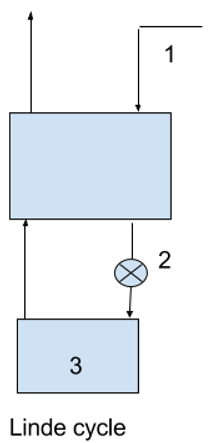This set of Chemical Industry Multiple Choice Questions & Answers (MCQs) focuses on “Inorganic Chemical – Cryogenics”.
1. Cryogenics deals with which type of product?
a) High temperature
b) Low temperature
c) High pressurize
d) Low pressurize
View Answer
Explanation: Cryogenics in chemical technology, deals with the production and utilization of low temperature in the region from absolute zero to 123 kelvin.
2. Which operation mentioned below is associated with Claude cycle?
a) External refrigeration
b) Three- stage cascade cycle
c) High-speed expander
d) Low speed expander
View Answer
Explanation: In the Claude cycle, a fraction of the gas is expanded in a high speed expander. External refrigeration and three- stage cascade cycle is related with Cascades cycle.
3. What is the use of ammonia in Linde cycle?
a) Precooling
b) Liquefaction
c) Refrigeration
d) Compression of feed stream
View Answer
Explanation: Linde cycle is the use of ammonia for precooling of the feed stream. Liquefaction is possible by compression or a combination of compression and cooling.
4. Which cycle is used in the production of low purity tonnage oxygen?
a) Linde cycle
b) Claude cycle
c) Kellogg process
d) Linde-Frankl cycle
View Answer
Explanation: The Linde and Claude cycle is used in the liquefaction of gases, kellogg process is to produced high purity oxygen. Thus Linde-Frankl is the only one which is used to produced low purity tonnage oxygen.
5. What is the amount of CO2 present in the raw materials for production of low purity tonnage oxygen?
a) 0.01-0.03
b) 0.02-0.07
c) 0.94
d) 20.97
View Answer
Explanation: The raw materials for production of low purity tonnage oxygen usually contain 20.97 oxygen, 0.01-0.03 water, 0.94 oxygen and 0.02-0.07 CO2.
6. What is the major difference between kellogg and Linde-Frankl process?
a) Recuperative heat exchanger
b) Catalytic oxidation chamber
c) Scrubbing tower
d) Refrigeration
View Answer
Explanation: The major difference between the kellogg and Linde-Frankl cycle is the use of a recuperative heat exchanger. These are built in a concentric triple-tube design with high purity oxygen moving through the inner tube, never contacting the air. This is known as recuperative heat exchanger.
7. Which process does not use air expansion for refrigeration?
a) Claude operated process
b) Elliott process
c) Turbo-reciprocating process
d) Liquefaction process
View Answer
Explanation: A novel process (elliott) does not use air expansion for refrigeration but sets up heat exchange with nitrogen coolant in strictly recuperative heat exchanger. Claude-operated process uses adiabatic expansion of 70-80% of the incoming air.
8. What is the composition of air entering the cold exchanger in Linde-Frankl cycle?
a) O2 and N2
b) Only N2
c) H2O and CO2
d) Only H2O
View Answer
Explanation: Air containing both H2O and CO2 which must be removed before entering the fractionation column operated at -183 to -195 celsius to prevent plugging in the Linde- Frankl cycle.
9. In nitrogen production which cycle is used Joule-Thomson cooling principle?
a) Claude cycle
b) Cascade cycle
c) Elliott cycle
d) Linde cycle
View Answer
Explanation: In Linde cycle refrigeration is used by joule thomson cooling in order to increase the temperature drop. In Claude cycle refrigeration is obtained by adiabatic expansion of compressed air in a turbo -reciprocating or rotating expansion machine.
10. What is 1, 2, 3 represent in the following flow chart?

a) 1-heat exchanger, 2-liquid reservoir, 3-throttle valve
b) 1-liquid reservoir, 2-heat exchanger, 3-throttle valve
c) 1-heat exchanger, 2-throttle valve, 3- liquid reservoir
d) 1-liquid reservoir, 2- throttle valve, 3-heat exchanger
View Answer
Explanation: At starting of Linde cycle exchange of heat of gases with a cold stream is done than this cold gases are allowed to pass through the throttle valve to a low pressure gas, than this cold gases are separated from the gas liquid mixture in reservoir.
Sanfoundry Global Education & Learning Series – Chemical Industry.
To practice all areas of Chemical Industry, here is complete set of 1000+ Multiple Choice Questions and Answers
If you find a mistake in question / option / answer, kindly take a screenshot and email to [email protected]
- Check Chemical Process Technology Books
- Practice Chemical Engineering MCQs
- Apply for Chemical Engineering Internship
- Check Chemical Engineering Books
